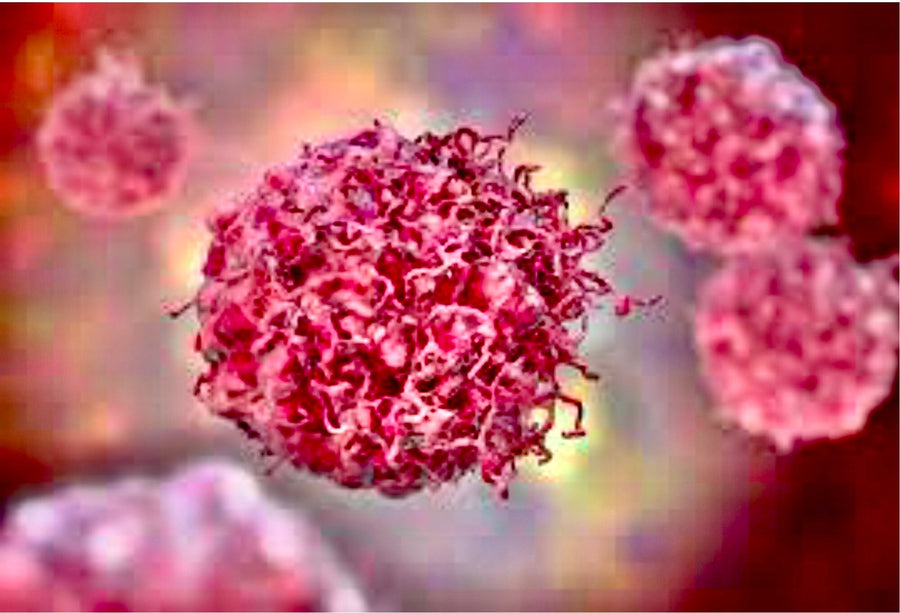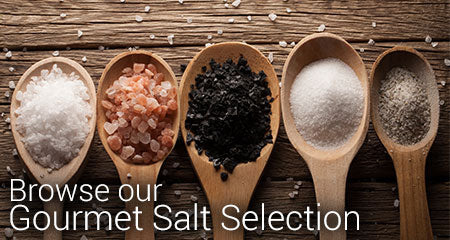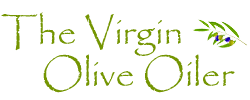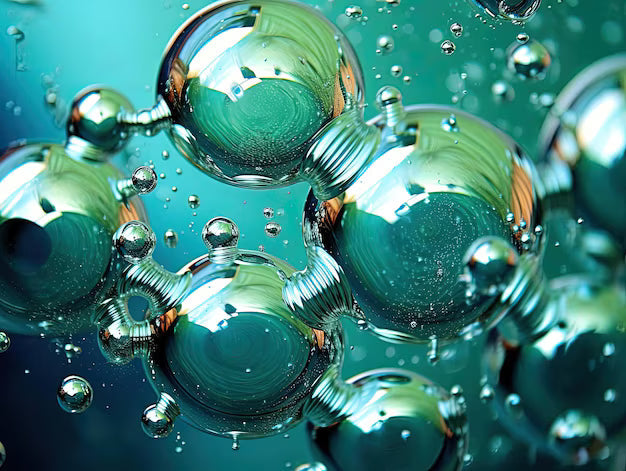Cancer and EVOO - Blog # 69

Hello everyone! Welcome back to another Friday blog. Cancer - it’s just scary. Unfortunately, rates are rising like crazy! WHY???
According to the CDC, in 2019 there were roughly 1.8 million new cases of cancer and roughly 600,000 deaths from cancer. Estimates for 2022 reach 1.9 million new cases and > 600,000 deaths. Breast cancer is in the lead (287,000) with prostate cancer right behind (268,000). Lung cancer is in 3rd place (236,000). Many other cancers in colon, liver, pancreatic, thyroid, bladder and kidney are higher than ever. Estimates now are that obesity will surpass smoking as the leading cause of cancer. Every person alive has oncogenes (cancer genes) in their DNA. What turns these genes on? How do we turn them off? How does cancer get started in the first place and what can we do to prevent it?
In 1931 Otto Warburg received the Nobel Prize in Physiology for his work on cancer. He was nominated 47 times for this award throughout his career. He studied the metabolism of tumors as well as the respiration of cancer cells and observed that animal tumors produce large quantities of lactic acid. He stated that even though there are countless secondary causes, “the prime cause of cancer is the replacement of the respiration of oxygen in normal body cells by a fermentation of sugar.” His observation that tumors ferment glucose in the presence of oxygen suggested a mitochondrial respiration dysfunction. This was a good starting place. We now know that there are genetic events that drive many cancers without affecting mitochondrial respiration. “Mitochondria play a central and multi-functional role in malignant tumor progression, and targeting mitochondria provides therapeutic opportunities.” Mitochondria make our energy in the form of ATP (adenosine triphosphate). Without them, we would not survive.
So, what are mitochondria and why do we need them? “Mitochondria are maternally inherited, cytoplasmic organelles that originated from symbiotic bacteria (Wallace, 2012).” So, these very special microbes that live inside our cells and make energy for us, come from our mother! Their “sisters” are the gut microbes. They communicate by sending the equivalent of text or instant messages to each other in the form of postbiotic molecules. They also relay signals aiding in innate immune function. And…they are paying attention to your thoughts. There’s food for thought.
Mitochondria have their own DNA and are the metabolic machinery of our cells. You can think of them sort of like a hybrid car capable of burning gas or switching to electric. They can either metabolize via the glucose (sugar-burning) pathway or switch to a ketone (fat-burning) pathway. The latter one being a bit cleaner. They are bioenergetic (use energy) and biosynthetic (make products) organelles that take up nutrients from the cytoplasm (such as glucose) to make these products for us. They also function as a platform for generating biosynthesis building blocks, synthesize proteins, fats, nucleotides (for DNA repair), heme and iron sulfur clusters and antioxidants to protect themselves from damage. 88% of Americans do not have a healthy metabolism - that is the ability to switch back and forth between burning glucose and burning fat. We tend to stay in the glucose-burning mode, which stores excess as abdominal fat.
Since mitochondria are SO important for our survival, it is imperative for us to understand what they need and what harms them. This is where toxins take a front seat.
1) Tobacco smoking - responsible for 20% of all cancers, 30% cancer deaths, 80% lung cancers. Smoking causes a “number of other diseases and can damage nearly every organ in the body, including the lungs, heart, blood vessels, reproductive organs, mouth, skin, eyes, and bones.” Some of the chemicals in cigarettes and tobacco products include:
- Nicotine (the addictive drug that produces the effects in the brain that people are looking for)
- Hydrogen cyanide
- Formaldehyde
- Lead
- Arsenic
- Ammonia
- Radioactive elements, such as polonium-210 (see below)
- Benzene
- Carbon monoxide
- Tobacco-specific nitrosamines (TSNAs)
- Polycyclic aromatic hydrocarbons (PAHs)
2) Environmental toxins: Glyphosate (Roundup), for example, is used on roughly 70% of our crops (apples, papaya, cotton, corn, sugar, soybeans, beets, canola, potatoes, summer squash, alfalfa - used for dairy cows, oats, lentils, beans, wheat, peas and millet). Oats tend to have some of the highest levels of glyphosate. “About 280 million pounds of glyphosate are applied to an average of 298 million acres of crop land annually.” It interferes with the shikimate pathway used by plants, mitochondria and most (54%) of our good gut microbes. End products of this pathway include important folates - B vitamins that are precursors to NAD and FAD that our mitochondria need to make energy - and aromatic amino acids - 3 of the coding proteins that are precursors to neurotransmitters - that we are not able to make ourselves. Glyphosate severely disrupts the balance of gut microbes reducing Lactobacillus and allowing overgrowth of the pathogen, Salmonella, which is resistant to glyphosate toxicity. It depletes Mn (manganese) from soil and plants as well. “Sperm motility depends on Mn, and this may partially explain increased rates of infertility and birth defects. We further reason that, under conditions of adequate Mn in the diet, glyphosate, through its disruption of bile acid homeostasis, ironically promotes toxic accumulation of Mn in the brainstem, leading to conditions such as PD (Parkinson’s Disease) and prion diseases.”
Wheat is further sprayed with potassium bromate, a known carcinogen that hasn’t been reviewed by the FDA since 1973!!! WHAT????????!!!!! Are you kidding? Several broad-spectrum pesticides are used on rice under the brand name Warrior and Mustang. “Chlorpyrifos is a type of organophosphate insecticide used to control pests like termites, mosquitoes, and roundworms. In agriculture it’s used as a spray to protect a variety of food crops like corn, soybeans, fruit, nut trees, and other raw crops.” Many other environmental toxins are found in plastics, makeup and skin-care products. Check out Charles’ handmade natural EVOO soaps and body products here!!
3) Heavy metals - Most of us don’t even realize the level of heavy metals in our bodies. The liver is the primary detoxification site. Enzymes in the liver add sulfate groups to heavy metals to make them less toxic and more water-soluble to be excreted by the kidneys. When this process is interfered with, as with glyphosate, toxicity rises. MD’s don’t even check these levels.
4) Diet - As it turns out, cancer loves sugar. When we eat a high carbohydrate/sugar diet as in the SAD (standard American diet), mitochondria produce a lot of “exhaust” in the form of ROS (reactive oxygen species). ROS are the free-radicals - the equivalent of a live electrical wire causing damage to everything it touches. When significant ROS are produced by the mitochondria, damage occurs both to our cells and to our mitochondria. This can cause DNA damage that leads to mutations or even kill the cell. Antioxidants are the neutralizers. They bind to ROS and neutralize them. This is why we want to eat a diet high in antioxidants and polyphenols!! #HP-EVOO# + the rainbow.
5) Obesity/Insulin Resistance (IR) - When we eat a high carbohydrate diet and spike our blood sugar repeatedly, our cells become resistant to insulin (hormone that delivers glucose to cell). This keeps our insulin levels high. Cells become overloaded and resist insulin. Insulin climbs higher to force glucose into the cell. When our body becomes overwhelmed with this, we store excess in the form of belly fat. This belly fat acts like an organ producing hormones and screwing with delicate hormone balance. It also produces inflammatory molecules, such as interleukin-6 involved in the cytokine storm. This is setting the soil conditions to be ripe for cancer to grow. High insulin levels (IR) increase the bioavailability of insulin-like growth factor (IGF-I) both appear to have a role in tumor initiation and progression. “Insulin and IGF-I inhibit the hepatic synthesis of sex-hormone binding globulin (SHBG), whereas both hormones stimulate the ovarian synthesis of sex steroids, whose effects, in breast epithelium and endometrium, can promote cellular proliferation and inhibit apoptosis. Furthermore, an increased risk of cancer among insulin-resistant patients can be due to overproduction of reactive oxygen species (ROS) that can damage DNA contributing to mutagenesis and carcinogenesis. On the other hand, it is possible that the abundance of inflammatory cells in adipose tissue of obese and diabetic patients may promote systemic inflammation which can result in a protumorigenic environment.”
6) Poor Sleep - “Poor sleep is consistently linked to the development of systemic disease, including depression, metabolic syndrome, and cognitive impairments. Further evidence has accumulated suggesting the role of sleep in cancer initiation and progression (primarily breast cancer). Indeed, patients with cancer and cancer survivors frequently experience poor sleep, manifesting as insomnia, circadian misalignment, hypersomnia, somnolence syndrome, hot flushes, and nightmares.”A metanalysis looking at roughly 362,000 individuals showed that shortened sleep duration is “significantly associated with incicidence of obesity.” Try to get 7-9 hours of sleep per night. Studies show <6 hrs increases cancer risk and death, particularly if you have cardiovascular disease or are diabetic.
7) Melatonin imbalance/deficiency - Also related to sleep, this important molecule is a powerful antioxidant able to inhibit many types of cancer. We produce a small amount from the pineal gland in the brain, but most we rely on from dietary intake and synthesis from our gut microbes. Studies reveal the “involvement of melatonin in different anticancer mechanisms including apoptosis induction (cell death), cell proliferation inhibition, reduction in tumor growth and metastases, reduction in the side effects associated with chemotherapy and radiotherapy, decreasing drug resistance in cancer therapy, and augmentation of the therapeutic effects of conventional anticancer therapies.” Bright light, such as blue light from computer screens, interferes with melatonin production and release.
8) Stress- chronic stress keeps cortisol levels high. This is our fight or flight response. It’s good when we need to run away from danger - increases blood pressure, heart rate, shuts down digestion (no time to poop when you’re running) - but not so good to stay in that chronic state. This leads to insulin resistance, obesity, HTN, cardiovascular disease, sleep issues and many other chronic health problems. Obviously, this is not a complete list.
So, what are some strategies to turn off cancer genes, turn on cancer-fighting genes, prevent cancer formation or even prevent a recurrence of cancer?
- Ketones - Create an environment not friendly for cancer cells - eliminate sugar, carbohydrates, processed foods, gluten and other foods that spike glucose and keep insulin levels up. Cancer cells utilize glucose and are not able to utilize fat (ketones) as fuel. Ketones create a stressful situation in cancer cells, but NOT in normal cells. A whole-foods ketogenic diet is a good strategy - both in prevention and as an adjunct therapy -
- Cruciferous vegetables - these sulfur donors are crucial!! Broccoli, asparagus, Brussel’s sprouts, cabbages…our neurotransmitters get sulfated (serotonin for example) in our intestines before being transported to the brain. The lining of our blood vessels are heavily sulfated. The liver requires it for detoxifying our bodies, and much much more.
- Eat Organic - as much as possible, avoid glyphosate. If money is tight, at least get the dirty dozen list - foods that you should NOT consume if not organic - include and increase consumption of detoxifying foods like EVOO, beets, cruciferous, dark leafy greens, green tea.
- Polyphenols - polyphenols are epigenetic masters - they are the directors of the symphony, turning off cancer genes and turning on cancer fighting genes as well as turning on anti-aging genes. Dietary phytochemicals such as tea polyphenols, genistein, sulforaphane, resveratrol, curcumin and others have been shown as effective cancer-protective, cancer-fighting and epigenetic agents. Polyphenols are in EVOO and colorful vegetables, fruits, green tea, fish, grass-fed beef… “cancer cells have genome-wide aberrations in a number of epigenetic markers, including global hypomethylation, global downregulation of miRNAs, promoter-specific hypermethylation, histone deacetylation and upregulation of epigenetic machinery. In addition, the impact of epigenomic processes in cancer is apparent by the finding that at least half of all tumor suppressor genes are inactivated through epigenetic mechanisms in tumorigenesis.”
- Decrease inflammation - eating foods high in polyphenols, phytochemicals, phytonutrients are powerful anti-inflammatory molecules. They neutralize ROS. The more inflammation you have, the more anti-inflammatory nutrients you need to consum.
- Melatonin - very powerful and important antioxidant involved with sleep, immune function, cancer-prevention, and many other functions- consume foods high in melatonin like pistachios daily - Our pineal gland is a small storage vessel for melatonin. The majority of what we need is made by our gut microbes and through dietary sources. You may be deficient if your gut is not healthy.
- Sleep - guard your sleep! Sleep is disturbed in most cancers, particularly breast cancer. Get bright sunlight in the morning, but turn lights down at sundown to set your circadian rhythm. Use blue-light blocking glasses if you are using a computer a lot or under bright indoor light.
- Reduce Chronic Stress - Rhythmic deep breathing, mindful meditation. Find ways to incorporate strategies to reduce your stress. Take 5…walk, breathe, go outside, read, sing, ACTIVELY counteract effects of stress.
- Fresh Air and Sunshine - Get outside. Get sunshine on your skin to synthesize vitamin D, promote wellbeing, reduce depression, even help to detoxify glyphosate -
- Oral Hygeine - We have a microbiome in our mouth that is of utmost importance. No one is really talking about it, but it is critical to our health and longevity. Researchers now understand that antimicrobial mouthwash is NOT a good thing. It can modify the balance of the microbiome in a negative way. Brush and floss to keep pathogenic microbes from inhabiting spaces deep in gums. “The microbes in the oral cavity and the oropharynx inevitably travel to the stomach, and if the bacteria can withstand the harsh pH of the stomach, it can ultimately reside and proliferate in the gastrointestinal tract. For example, Helicobacter pylori, an infectious bacterium that leads to gastric cancer, also has a presence in dental plaque.” Further, pathogenic microbes the migrate from the mouth are known to be a contributing cause of Alzheimer’s Disease, dementias, Rheumatoid Arthritis and many other chronic diseases.
- Lycopene - A bright red carotenoid in red fruits/vegetables, concentrated in cooked tomatoes and red carrots, and helps fight and prevent prostate cancer. Eating with EVOO and avocado enhances the cancer-fighting properties 400%!! A review published in Medicine looked at “26 studies with 563,299 participants found both lycopene supplementation and circulating concentrations exhibited a preventive effect on PCa (prostate cancer).
- Minerals - make sure to get your trace minerals - these are depleted from the soil due to glyphosate and other metal chelators. They are important co-factors for enzymes. For example, zinc is responsible for >300 enzymatic reactions, magnesium >600.
- HP-EVOO - High Polyphenol Extra Virgin Olive Oil contains phenolic alcohols, hydroxytyrosol, tyrosol and secoiridoids including oleocanthal (like ibuprofen in anti-inflammatory action), oleacein, oleuropein, ligstroside and others. “Secoiridoids have antioxidant, anti-inflammatory, and anti-proliferative properties and, therefore, exhibit anti-cancer activity.” A “systematic review and meta-analysis comprising data from 45 individual studies reveals that, overall, highest versus lowest olive oil consumption was associated with 31% lower cancer risk.” This was for ANY type of cancer. Significant protection was noted for breast, gastrointestinal, upper aerodigestive and urinary tract cancers. Gastrointestinal cancer was 23% lower for those who consumed the highest amounts of EVOO as well as an inverse association with EVOO intake and urinary tract cancers. “EVOO secoiridoids constitute a new family of plant-produced gerosuppressant agents that molecularly “repair” the aimless (and harmful) AMPK/mTOR-driven quasi-program that leads to aging and aging-related diseases, including cancer.”
So, until next time my friends, EAT TO BEAT CANCER!!!…Drink, Drizzle, Digest HP-EVOO 2-4T raw daily, - use more for cooking - eat the rainbow of veggies (7-9 C) and low-glycemic fruits (to get the rainbow of gut microbes!) organic or wild-sourced, eat wild-caught, pasture-raised, grass-fed, get plenty of sunshine + supplement magnesium, zinc, vitamin D3 + K2, get your trace minerals and electrolytes with good sea salt *Himalayan was formed before plastics, eat foods high in lutein, drink your body weight in oz of water, get a good pre/probiotic (if you have wiped out your gut microbes with antibiotics), consume indigestible fiber for your gut microbes, eat some adaptogens and methylation donors (kale, beets, lion’s mane…) to detox, enhance overall health and reverse aging and disease, exercise your body and mind, add a few minutes of mindful meditation to your day to combat stress, take a hot bath and follow with a cold shower or plunge, remove EMF (electromagnetic frequency) devices and blue light, use IR (infrared) from candles (check for toxic chemicals), fire or incandescent lights in the evening to enhance sleep and...turn off the light!! #HP-EVOO
This blog is intended for informational purposes only. Discuss strategies with your Healthcare Practitioner.







Comments (2)
Do you have any brands of minerals, melatonin and such that you recommend? I know they are not all created equal.
Hi Lisa!
Thanks for your question. When it comes to minerals, such as magnesium, there are several to choose from based on what’s going on with you. Some can cause diarrhea – an unwanted side-effect – unless you are constipated…Generally, magnesium citrate is a good option. I would look for 3rd party testing for any supplement – although it might be a little higher priced. When it comes to melatonin, the BEST thing you can do is fix your gut. The gut microbes are the biggest producers of melatonin. Feed them HP-EVOO, polyphenols in the rainbow of veggies and fiber, including indigestible fiber. GOS (galactooligosaccharide) is a wonderful option as well as Konjac root. Also, consume foods high in melatonin – raw pistachios are the highest. Results from oral supplementation are quite varied and there’s no regulation. Get exposed to bright sunlight first thing in the am to set your circadian rhythm. If you’re eyes are exposed to blue light very much during the day, as in looking at a computer screen or being under bright indoor lighting, wear blue-light-blocking glasses. Turn down lights at dusk, gearing toward more red-spectrum light.
Hope this helps!!
Health and happiness to you and yours
Julie